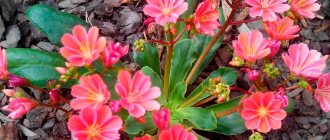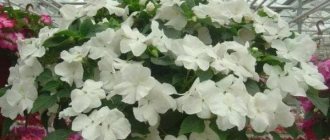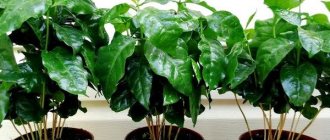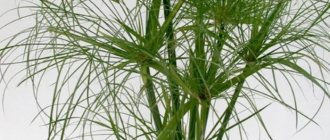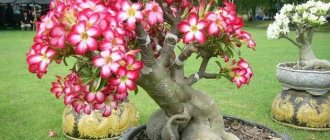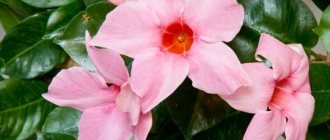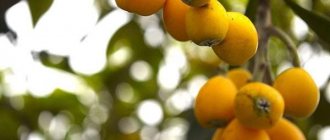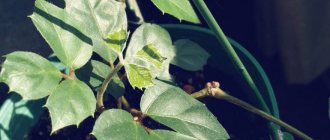Zebrina
Latin name: (Zebrina)
Category: herbaceous shrubs
Homeland: Central and South America, Antilles
Striped miracle zebrina
Zebrina (Zebrina) is a herbaceous, very decorative, ground cover, unpretentious perennial in the Commelineaceae family.
It is impossible to deny that the zebrina belongs to the Tradescantia, but the differences are obvious.
Firstly, these are the incomparable stripes on the oval, pointed leaves, the upper side of which is shiny, green-silver, and the back of the purple-violet hue.
This beauty is located on young erect stems that droop with age. The base of the flower is a not very deep root system.
The original coloring of the leaves of the flower gave rise to its interesting name zebrina or striped.
The second distinctive feature of the zebrina can be considered its direct relationship to witchcraft.
Tradescantia zebrina has medicinal properties very similar to those of great and famous homeopaths such as Kalanchoe , aloe, geranium.
Chlorophytum and spathiphyllum can partner with this striped miracle to purify indoor air.
Thanks to the latest research, antibacterial elements with a unique ability to lower blood sugar have been discovered in zebrina leaves; the presence of natural phytoncides gives the plant the ability to help the body fight microbes and viruses, burns and even stomach ulcers.
People say that the zebrina flower (mallow) has psychic abilities. The flower reacts to negative and positive territories. The general appearance of the plant changes. The presence of a beautiful zebrina improves mood and well-being, improves relationships between family members and relatives.
Zebrin plants consider the tropics of the American continent, its central and southern parts to be their native territories.
Zebrina species
Hanging zebrina (Zebrina pendula)
This is the most common variety in domestic culture, coming to us from the tropical rainforests of Mexico.
When creating conditions close to natural, your deciduous and ornamental perennial, which has creeping, ascending stems, will look charming.
On the hanging, quickly rooting stems, beautiful six-centimeter egg-shaped leaves with elongated tips were arranged in two rows.
The upper side is reddish-green with silver stripes, and the lower part of the leaf is purple. Zebrina blooms with hanging small pinkish flowers.
Zebrina purpusii
Perennial, fast-growing, undemanding flower. On an olive-reddish stem are lilac-purple leaves covered with delicate fibers. The lower part of the leaf is purple with a reddish tint. Indoor zebrina will have rich leaf colors in good, intense light. It blooms with small lilac flowers.
In the photo the zebrafish looks very attractive.
Zebrina pendula f. quadricolor
The lush color of the leaves distinguishes this variety. The central part of the leaf is green with a hint of metal, and the edges are red-green with whitish stripes. The reverse side of the leaf is purple.
Zebrina care at home
Growing zebrina is not at all troublesome. Both beginners and seasoned florists can easily cope with this event. And then Tradescantia zebrina will not only decorate the territory with its presence, but will also purify the surrounding air and lift the mood of the owners.
Selecting a location
For a clear and bright color, the zebrina needs a lot of bright light, but not direct rays of the sun. It will look great in the form of an ampel flower at a distance of half a meter to two meters from a brightly lit window, or in the partition between the windows. Windows with east or west orientation will be acceptable.
A lack of light will spoil the beauty of the flower - the stems will stretch and the leaves will turn pale.
You need to pamper your zebra with fresh air. In the warm season, she will feel great on the balcony or terrace. Garden zebrina, planted in open ground, will decorate a summer cottage or park area with its charming and graceful appearance.
Remember! The zebrina plant does not like smoking people or smoky rooms.
Temperature
The ideal option is 17-23˚С. The allowed lower temperature limit is 13˚C.
How to water zebrina?
In summer we water moderately every three days, and in winter – sparingly every seven days. A light shower and regular spraying of the leaves will be beneficial and pleasant for the zebra, which will maintain the necessary air humidity in the room.
Main! Do not allow water to stagnate in the flowerpot so that the roots do not rot and the plant dies.
Soil and fertilizing
Indoor zebrina is absolutely not demanding on the composition of the soil mixture. It can be prepared from equal parts of peat or compost, sand and garden soil.
Liquid fertilizers will be the optimal feeding for indoor zebrafish. Additionally, you can stimulate indoor plants with banana skins, potato peelings, liquid vermicompost, potassium sulfate, eggshells, charcoal, yeast, and the Zircon preparation.
We must remember! An overabundance of stimulants can weaken zebrina.
Zebrina breeding
The indoor zebrina plant can be propagated easily at any time of the year, just like hoya or ivy . Strong cuttings you like can be rooted, if desired, in water or directly in an earthen mixture. When planted in a wide pot along the walls, the cuttings will take root even without a mini-greenhouse.
For three years, the zebrina flower, with regular pruning and the formation of a lush bush, will be a beautiful and attractive miracle. When the plant begins to lose its decorative effect, it is renewed again.
Zebrina pests and diseases
Indoor zebrina is among the disease-resistant plants. If the zebra's care was not of good quality, you can expect some troubles.
It may be visited by unexpected guests in the form of spider mites, aphids, scale insects, and thrips. Diseases caused by insects spread quickly. We urgently control pests using a soap solution.
If there are no positive results, we use chemicals.
Difficulties in growing
- The leaves turn pale, the stems stretch out - poor lighting.
- White spots on the foliage, stems rotting - excessive watering and too high humidity.
- Indoor zebrina grows very slowly - lack of nutrition.
- The leaves become brownish - increase the amount of watering.
The zebrina plant, which is carefully looked after at home, will be an excellent decoration for both living rooms and offices. You can place the plant closer to the TV or computer to take advantage of its ability to absorb electromagnetic radiation.
It will look especially impressive in compositions with flowers with monochromatic leaves.
Source: https://faterra.com/katalog-komnatnykh-tsvetov/zebrina.html
Difficulties in growing
The plant is resistant to diseases and pests. Occasionally you can find spider mites, scale insects, and aphids. Affected leaves quickly turn pale; upon closer examination, pests can be found on both sides.
When infected with spider mites, cobwebs appear in the internodes. Aphids love to attack young shoots. To control pests, Tradescantia is washed with soapy water. If the damage is severe, appropriate insecticidal preparations are used.
Other problems are associated with errors in care:
- The shoots are bare, the lack of leaves is due to a lack of light, feeding, and water.
- The leaves have lost their variegation - Tradescantia does not have enough light.
- The leaves are drooping, turn yellow, and become covered with spots - lack of moisture.
- The tips of the leaves dry out and turn brown – the air in the room is too dry.
- The leaves have drooped, thinned, become translucent, watery - this is a sign of problems with the root system. The soil was either flooded or dried out. If the soil is dry, water the flower, this will help revive the Tradescantia. If the plant is not getting better, you can take the best cuttings and root them.
Zebrina
This plant belongs to a separate species and is considered an independent plant. Despite the fact that it is inherently traditional, it has its own specific place among indoor plants. At the same time, zebrina is very different from many Tradiscantia.
Firstly, by its coloring, as a result of which it got its name. But not everyone knows that this plant has a whole range of unique healing properties. If you list a number of diseases that zebrina can cure, it will be a huge list, which includes diseases such as cholera.
At the same time, it helps get rid of burns.
It has natural air purifying properties, as do the entire Tradiscantia family, including Spathiphyllum, Chlorophytum, etc.
Thanks to her abilities, she can successfully replace her other relative - callisia, or more precisely, its variety Golden Mustache.
Its antibacterial properties and ability to heal wounds place it alongside well-known plants such as Kalanchoe and aloe.
Among other things, this plant is simply adored by pets, especially cats, who see it as a replacement for the herbs that they find on the street if they feel unwell. It is quite possible that if there is a cat in the house, he will definitely graze on it. At the same time, not only cats, but also birds, turtles, etc. love her.
Caring for a zebra at home
Caring for this plant is the same as caring for Tradiscantia, but there are some differences.
Location and lighting
This is an ampel plant and its place is on a separate stand or when organizing a hanging option. Zebrina loves light very much, so the best place may be a partition between two windows, where there is enough light and no direct sunlight, which can destroy the plant. It is very important that the room where the zebra is located is constantly and regularly ventilated.
There should be no smoke in the room due to smoking. The zebrina may not survive such extreme conditions.
In the summer, it would be a good idea to take it out into the fresh air. Sometimes it is planted in open ground, just like geranium or tuberous begonia, where it looks very good.
Watering, fertilizing, air humidity
Many claim that this plant loves abundant watering, but the other half of gardeners say something else.
Most likely, for the normal development of this plant, optimal watering is needed, because excess moisture is harmful and the plant begins to lose its decorative appearance, while the soil should not be allowed to dry out.
Optimal watering is that at normal room temperature, it is enough to water the zebrina twice a week. In winter, the dose is reduced by half.
Air humidity does not particularly affect the development of the plant, since it thrives in dry air conditions, although more humid air is preferable. To somehow compensate for the lack of air humidity, the plant should be sprayed regularly.
You should be very careful with fertilizing so that it does not cause harm, because excess fertilizer also has a negative effect on the zebrina. Fertilizing is done with complete mineral fertilizers, and their dose should be half as much as recommended.
Planting and transplanting
The zebrina does not need to be transplanted, since its life as a decorative element is quite short. She is interesting for the first 3 years of her life, after which she will lose her attractiveness. Therefore, it is better to grow a new plant than to replant an old one, which is what many gardeners do, especially since it is quite simple to do.
When planting, you can use a fairly simple recipe for preparing the soil:
- 2 parts leaf soil.
- 2 parts of turf land.
- 1 part sand.
Reproduction
Propagating this plant is as easy as shelling pears and can be done throughout the year by rooting cuttings. The technology for propagating zebrina is similar to the technology for propagating tradescantia, ivy, hoya, stephanotis, etc. You can root cuttings in various ways, including in water.
But it will be easier if the cuttings are planted directly in the ground. To do this, you need to take a small pot (11cm in diameter) and plant several cuttings in it at once, next to the walls of the pot. After the cuttings take root, they can be planted in pots or left to grow further.
Tradescantia. Cuttings, transplantation and re-rooting.
Useful properties of zebrina
Many breeds, even in ancient times, used this plant as a medicine. In Buddhist monasteries, this plant had a cult character and was certainly grown.
Latin Americans used the crushed leaves of this plant and applied it to purulent and other wounds, as well as to tumors and bruises. Fresh zebrina juice helped relieve pain and helped with tuberculosis. In Cuba, various diseases were treated by ingesting a decoction of its leaves.
These were diseases such as colitis, flatulence, cholera and other diseases of the gastrointestinal tract.
Research has shown that it contains unique elements that can lower blood sugar levels, as well as natural phytoncides that can kill germs and viruses. This is due to its high antibacterial activity.
Zebrina, having settled in an apartment, will help purify the air, which will lead to ease of breathing. She has a very keen sense of how environmentally friendly a home is. If the housing has geopathogenic problems, then zebrina may not take root.
Zebrina hanging. Planting and care.
Source: https://rastenievod.com/zebrina.html
Tradescantia zebrina: home care, transplantation, propagation, photo
Tradescantia zebrina , formerly pendula, belongs to the Commelinaceae family.
This plant has a rich history of use in traditional medicine, and among Buddhists, Tradescantia zebrina generally had a cult character and was necessarily grown in every temple.
Among Latin Americans, crushed leaves were used to treat purulent wounds and bruises, in Cuba they drank freshly squeezed juice to relieve colitis, flatulence, and treat cholera and other gastrointestinal diseases, and a little later in Europe, zebrina juice was used to treat tuberculosis.
It should be noted that this value of zebrina is not taken out of thin air - many studies have shown that it contains a large number of useful microelements, which have not only medicinal properties, but also the ability to purify the air in the apartment from pathogenic organisms.
Therefore, Tradescantia zebrina will not only be a beautiful hanging decorative foliage addition to your apartment, but will also bring great benefits to the atmosphere of your home.
Description of the plant
The Latin name of the flower is tradescantia zebrina. Family Commelinaceae.
The herbaceous evergreen perennial grows quickly - the length of the stems can reach 1.8-2 m, the height is no more than 15 cm.
The leaves are sessile, oval with pointed tips, 7-10 cm long. The color is varied - the inner side is purple, the outer side is green with thick silver and thin purple stripes.
The plant blooms with small three-petal inflorescences of pink, snow-white or purple tones.
The flowering period occurs in spring and summer.
Botanical characteristics
In the wild it grows in tropical rainforests, along river banks and wetlands in Mexico, Central America, and Colombia. Small plantations are present in South America, Africa, Asia and Australia.
Belongs to herbaceous semi-succulents. In its natural environment it grows up to 1.20 m. When grown at home, it has a compact shape. With properly organized care, it grows intensively in the form of a lush creeping clump.
Description:
- height varies from 15 to 60 cm;
- the stems are flexible, the growth is cascading and creeping, they have the ability to take root in the soil, there is no pubescence, the color is in shades of red and green;
- foliage up to 5 cm long, oval shape, pointed at the ends, variegated color, pink-violet, glossy surface with a characteristic shine, most varieties have silver stripes on the sides, the underside is purple-violet,
- umbellate inflorescences, formed by small three-petalled pink-violet flowers;
- the root system is formed by fibrous branches growing in breadth;
- fruits in the form of a three-leaf capsule, the number of seeds is usually 2 pcs.
Zebrina blooms when grown in open conditions from late spring to early summer. Indoors flowering lasts from September to February.
Varieties
Indoor Tradescantia has several decorative varieties that are valued in home floriculture.
- Hanging, or drooping (often called the “Wandering Jew”). The most popular type, has healing properties. The leaves are large, ciliated, reddish-green in color with silvery longitudinal stripes. The bottom of the leaf is purple-red.
- Red Hill. A beautiful plant with emerald leaves, a bronze tint and gray stripes. Purple on the underside. This hybrid is grown in hanging pots and baskets. It is a ground cover variety and therefore suitable for growing in a flower garden.
- Setcreasea purpurea (Purpura, or purple heart). A lush plant with numerous stems, densely covered with dense leaves. The surface of the leaf blade is reddish-olive, contains slight pubescence, the underside is bare and purple.
- Flocculosis. It is distinguished by white leaves with fine hair.
Medicinal properties of Tradescantia zebrina
It is impossible not to mention the medicinal properties of zebrina. American folk healers put it on a par with the legendary aloe. Even their healing properties are similar: both are used to treat diabetes.
Zebrina has bactericidal properties. Since ancient times, Tradescantia has been grown in Buddhist monasteries for medicinal purposes.
The leaves were crushed, the resulting pulp was applied to bruises, wounds, scratches, and even tumors were treated. Freshly prepared juice cleansed purulent wounds, relieved pain, and was taken for tuberculosis.
On the island of Cuba, a decoction of the leaves was used for diseases of the digestive system.
Tradescantia is considered a natural air purifier, not inferior to chlorophytum, callisia and other plants.
The herbaceous plant is a real treat for pets. When cats feel unwell, they eat tender leaves, which replace street medicinal grass for them in the winter. Turtles, birds, hamsters and even fish love to feast on them.
Purchase and adaptation
You can buy striped tradescantia in one of the flower shops. To get a strong and healthy plant, you need to carefully examine its above-ground part:
Source: https://kursi-floristiki.ru/komnatnye-cvety/tradeskanciya-zebrina.html
Indoor zebrina: home care, photo, reproduction
Zebrina is a very attractive ornamental plant that is well known to many gardeners. Caring for it is not particularly difficult. However, in order to grow a lush flower, you must adhere to certain rules. We will consider the features of growing zebrina at home in this article.
Botanical description of the plant
In the large Cammeline family, the Tradescantia genus stands out, to which the evergreen perennial Tradescantia zebrina belongs. It blooms in spring and summer, when small flowers appear on its stems, perfectly matching the tone of the leaves.
In the wild, Tradescantia zebrina forms entire “carpets” covering hills and meadows. And at home it is grown both as a houseplant and as a garden plant, which is used in arranging alpine slides. The flowering of indoor zebrina has its own characteristics:
- the flowering period can occur in any season;
- it lasts for 3–4 months;
- at this time, many buds appear on the plant, blooming several times a day and fading within a day;
- the inflorescence consists of green cups with light petals and corollas, in the center of which there are long yellow stamens.
Important! When Tradescantia fades, small elongated boxes with vertical ribs are formed in place of the buds, where the seeds are contained.
| Root system | branched, superficial |
| Stem | smooth, curly, purple in color, reaches 80–90 cm |
| Leaf Shape | oval, arrow-shaped; they reach no more than 7–8 cm in length and 3–4 cm in width |
| Leaf color | dark green with lilac and silver streaks |
| Flower shape | small inflorescence with three petals |
| Flower color | lilac |
Medicinal properties
Tradescantia is not only a beautiful flower, but also a useful one in the household: its leaves, stems and juice have healing properties:
- Milk from zebrina leaves is used to treat small wounds, scratches, and the consequences of skin diseases, because this liquid has an antibacterial effect;
- the ground leaves of the plant are spread into a paste onto the boils under a bandage to alleviate the condition and relieve swelling;
- some elements from the composition of the flower are used to make drugs that lower blood sugar levels;
- Infusions are made from young shoots and fresh leaves of zebrina to combat diarrhea and some intestinal infections;
- Many people use decoctions of Tradescantia in the treatment of sore throats and diseases of the oral cavity.
The use of plant-based drugs has no contraindications, however, like any active substance, it requires caution, so it is better to consult a doctor before starting such treatment.
Comfortable conditions and proper care at home
Zebrina is an unpretentious indoor inhabitant, but still, in order to maintain her healthy, thriving appearance, she should be provided with certain conditions and timely care.
Lighting and ventilation
In the wild, Tradescantia is more resistant to sunlight, but at home it does not like direct rays, which can leave burns on the leaves.
The optimal place in the house for this plant will be an eastern or western window sill. There, diffused light predominates, thanks to which there is no shortage of lighting, but the rays of the sun do not cause harm. Growing in the shade, the plant will lose its attractive appearance.
Loves plants and fresh air. It feels great on the balcony, in a well-ventilated area, just make sure there are no drafts.
Air temperature and humidity
Tradescantia prefers warmth, but it thrives at temperatures of +10...+13 ºC and +28...+30 ºC. The plant calmly tolerates temperature fluctuations during the day; only during the flowering period it is worth providing it with a warm and stable microclimate.
In addition to heat, humidity is also important for zebrina. Excessive dryness provokes the development of diseases and also makes leaves and stems vulnerable to pests. A regular spray bottle will help provide the necessary humidity in the room. Using it, spray warm, settled water next to the flower, but try to avoid getting the liquid on the leaves.
Watering
When moisturizing the soil in a Tradescantia pot, remember simple rules that will help ensure the healthy development of the plant:
- the frequency of watering depends on the temperature: in summer, moisture evaporates faster, so you need to water more often;
- the soil in the pot should always be moist, but not wet;
- The soil needs to be watered as soon as the top layer of soil dries out.
Most of all, indoor plants love rainwater. If this is not possible, then the best option would be ordinary water at room temperature, which has been left to settle for several days.
Fertilizer application
To feed indoor Tradescantia, both organic fertilizers and ready-made complexes for the decorative deciduous family are used. However, this plant should be fertilized carefully. Excess vitamins and minerals can lead to loss of leaf color and deformation.
Important! To prevent leaf color from fading, from the beginning of spring, feed zebrina once every 3 weeks, using half the amount indicated on the package.
Trimming
Thanks to the shoots that quickly take root in a new place, the zebrafish actively occupies the territory, so it needs to be limited in a timely manner. As for the indoor plant, it is pruned, eliminating yellowed, outdated shoots. So Tradescantia not only looks neater, but also healthier.
Transfer
Due to active growth, this type of bindweed regularly needs replanting. There are no specific deadlines for this; you just need to monitor the condition of the plant itself. And as soon as you realize that there is no longer enough space in the pot, you need to replant.
To do this, find a new suitable flowerpot. It should be low, but wide, so that there is enough space for the grown zebra, otherwise its development will stop. But remember that too large a container can cause a problem and lead to acidification of the soil. And be sure to ensure there is drainage in the pot.
As for the soil itself, you should choose nutritious and loose soil.
For transplants, peat substrates are usually purchased, but many amateurs make suitable soil themselves, using a 2:1:1 ratio:
- garden soil (neutral or slightly acidic);
- humus;
- peat.
If desired, the mixture can be supplemented with a small amount of river sand.
Propagation by cuttings
The process of propagating Tradescantia is very simple and consists of just a few steps:
- To begin, pinch the stem (10–15 cm high) above the leaf or at the site where the internode forms.
- Then it is left in a container with water until roots appear (usually this takes 7–10 days).
- After this, the young shoot can be planted in a separate pot, covering it with film for the first time to create a suitable microclimate (+15...+18 ºС).
Just don’t expect the sprout to immediately begin active growth: sometimes it may take a seedling about a month to take root in a new place.
Important! The best period for separating a new plant is considered to be spring-summer - it is at this time that the best conditions for its growth.
Difficulties in growing
Zebrina rarely gets sick or suffers from pests, but she has her own difficulties in development, provoked by improper location or care:
- if the plant’s leaves wither and lose color , the problem is the lack of sufficient moisture;
- if the leaves turn yellow , carefully examine their undersides and the zebrina's axils; perhaps there is a tick or scale insect there. If no pests are found, then the problem is insufficient humidity in the room;
- Sometimes the greenery of Tradescantia loses its brightness and juiciness. In this case, the problem may be a lack of light;
- It happens that zebrina does not grow its crown for a long time. Such a slowdown in plant development is provoked by a lack of proper lighting, as well as regular fertilizing.
If you are unlucky and the plant falls victim to pests, then you need to know how to deal with them.
Washing the plant with soapy water or garlic infusion will help prevent mites and aphids. However, when there are too many insects, it will be more effective to purchase insecticides.
In order for the lush, sparkling crown of the zebrina to please the eye, it is necessary to carry out its pruning, replanting and feeding in a timely manner. Although the flower can grow in the fresh air, in a garden or flower bed, it is still better to grow it indoors.
Source: https://fermer.blog/bok/komnatnye-rasteniya/dekorativno-listvennye/1499-cvetok-zebrina-uhod-v-domashnih-usloviyah.html
Zebrina: 115 photos, description, planting, reproduction and video instructions for care at home
Zebrina is a species of Tradescantia, a plant belonging to the Commelinaceae family. Zebrina is bred in homes and offices due to its ease of care. Its homeland is Mexico and Central America.
Zebrina is popular as a houseplant primarily due to its intricate colors, which vary depending on the species, but are distinguished by a characteristic feature: stripes along the leaves.
In any photo of a zebra, these stripes are clearly visible.
What types of zebrina are there?
There are four varieties of zebrina, the most popular as indoor plants.
Zebrina hanging. This type of zebrina grows with drooping shoots. The small, dense leaves of this variety have an oblong shape. There are two oblong silver-gray stripes along the top of the dark green leaf; below, the zebrina leaves have a dark reddish-purple tint.
Zebrina purpus. The leaves of this variety of zebrina have a vibrant violet-purple hue. There are also two white stripes along the top of the leaf, but, unlike Zebrina pendula, they are thinner and have a less contrasting color.
Zebrina pendulosa quadruplet. The leaves of this species of zebrina are purple underneath and dark green on top with longitudinal red or silver stripes.
Zebrina flocculosis. The leaves of this variety have a calm light green or whitish color.
How to propagate zebrina?
Zebrina has one drawback: its lifespan is not too long for a houseplant. The attractiveness of zebrina is lost after 2-3 years, the leaves become pale, and the shoots become stiff and bare. Therefore, it is better to grow a new zebrina; fortunately, this is quite easy to do yourself at home.
Zebrina is very easy to propagate using cuttings. You should take several strong, healthy cuttings and transplant them into the ground along the walls of the pot. You can also place the cuttings in water and transplant them into separate pots with soil after they take root.
Diseases and pests
The main reason for the poor health of this plant may not be so much pests as improper care. If the zebrina is kept in an insufficiently sanctified place, it will lose its decorative appearance, the leaves will become small, and the shoots will become elongated.
Excessive watering can lead to rotting of the root system and thinning of the leaves, overdried soil can lead to pale leaves and drying of their tips.
The most dangerous pest for zebrina is the spider mite. If you notice cobwebs on the leaves, immediately treat the flower with specialized preparations that kill spider mites and prevent their further appearance.
Photo of zebrafish
Bloom
Tradescantia rarely blooms at home, but many gardeners say that when comfortable conditions are created, small flowers with three petals of bright colors appear on the shoots.
Zebrina flower in the photo:
Zebrina - caring for the plant at home
Among the unpretentious and at the same time attractive indoor plants is Tradescantia zebrina, which even a novice gardener can grow. Thanks to its ampelous shape, this plant can be grown in a flowerpot on a balcony, window, wall or closet.
This perennial herbaceous plant from the Tradescantia genus and the Commeliaceae family is a resident of the tropical rainforests of the American continents (southern North America and all of South America), with Mexico being the homeland of this particular species.
The cultivation and cultivation of this tropical plant was carried out by John Tradescan, who was the chief gardener under King Charles I.
Representatives of this genus have common characteristics that distinguish them:
- roots penetrate shallowly into the soil;
- stems with a cylindrical cross-section are long (up to 1 meter), smooth, with branches falling down;
- the leaves grow alternately, are oval-shaped with a pointed end and are brightly colored: purple-violet on the bottom and stripes of green, crimson and silver on the underside.
At home, this plant practically does not bloom , but in natural conditions, small lilac flowers with three petals appear in the spring.
Important! Tradescantia violet has several subspecies: hanging (hanging), purpusa and flocculosis, which differ in the color of the leaves and their drooping.
Looking after Tradescantia at home
This type of Tradescantia attracts gardeners not only with its unusual and attractive appearance, but also with its ease of care.
At the same time, growing this flower in the house will ensure round-the-clock air purification and saturation with phytoncides , and the leaves also have a bactericidal and disinfectant effect.
It helps create a favorable atmosphere and is liked by pets.
Location
Due to its ability to grow quickly and its hanging shoots, zebrina will need to provide space and air, so it is most often hung or placed higher.
If you intend to grow on a windowsill, then it is better to choose the windowsills of western and eastern windows.
Also in summer, it is allowed to plant the plant in open ground, since such a flower will decorate any landscape.
Illumination
Zebrina loves light, but both with an increased amount of it, especially direct sunlight, and a deficiency, it begins to weaken, lose the variegation of leaf color and fade. Therefore, the plant should be provided with bright and at the same time diffused light. But exposure to direct sunlight in the morning and evening hours is allowed.
Landing
For planting Tradescantia zebrina, it is better to choose not very deep and fairly wide pots, made mainly of ceramics. Such containers will allow the plant’s root system to be located close to the surface and ensure good conductivity of water and air. It is also possible to use plastic containers, but this will require additional loosening of the soil.
The soil for this flower should be loose, water- and breathable and fertile. To do this, you can purchase ready-made soil in the store or prepare it yourself by mixing humus (1 part), garden or turf soil (2 parts) and river sand (1 part). Be sure to create a good drainage layer at the bottom of the container.
Plant cuttings or an adult plant are placed in moist soil and watered as needed.
It is also allowed to feed the flower with complex fertilizers no more than once every two weeks, but you should monitor its condition very carefully, since overfeeding with fertilizers and humus can cause the plant to lose its attractive color and become simply green.
Watering
Despite the moisture-loving nature of this plant, watering should be done as needed, since it can easily be destroyed. Due to a weak root system, prolonged drought leads to its damage, and excessive moisture content will lead to rotting of the roots and death of the entire plant.
Important! Watering should be done when the top layer of soil dries a couple of centimeters. It is also recommended to periodically spray, lightly wipe with a damp sponge or rinse Tradescantia leaves in the shower.
Transfer
Transplantation at home is carried out for young plants every year in the spring and for adults - no more than once every 2-3 years.
Also, replanting should be done after purchasing a flower in a store a few weeks later. Transplantation is carried out using the transshipment method to minimize the risk of injury to the roots.
After planting in a new pot with moistened soil, watering should be carried out as the soil dries.
Also, this plant is not afraid of pruning, so it is preferable to trim adult plants, removing long and bare shoots. Moreover, this method of “rejuvenation” promotes branching and the growth of new young shoots.
Botanical description
This plant was first noticed by the gardener John Tradescan, who served under King Charles 1 of Great Britain. This gardener was also a scientist and studied unknown varieties of plants growing on the recently discovered American continent and classified them.
The creeping tradescantia attracted his attention with its beautiful decorative appearance, so the gardener decided to cultivate this wild plant, suggesting that it would take one of the leading places in the decoration of premises.
This plant quickly increases its vegetative mass. During the season, young shoots, first growing vertically upward, as they grow, begin to descend and spread along the soil, and their length can reach 75-80 cm.
Tradescantia is a hanging plant and is famous for the extraordinary decorativeness of its foliage, which is why it is used by flower growers to decorate apartments, offices and other premises.
The main leaf color comes in the following colors:
In the photo there is a violet Tradescantia zebrina:
And the color of the longitudinal stripes on the upper side of the plates can be:
These stripes run along the stripe of the main color, bending around it at the end of the sheet. The edges remain dark.
The size of the medium-length oval leaves is 6.5 * 3 cm.
Indoor tradescantia blooms extremely rarely, and only a few gardeners can boast that this plant blooms regularly. The flowers are small, three-petaled. The color of the petals can be purple, lilac or pink.
The buds usually bloom during the summer and are located in the axils of the leaves at the tops of the shoots.
Tradescantia descends down in a multicolored cascade of shoots and variegated foliage, so flower growers gave it the following names: woman's gossip, mother-in-law's tongue.
